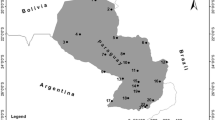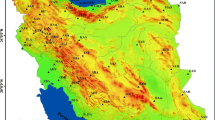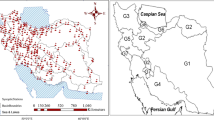Abstract
Satellite products are recognized as important resources providing significant and high-resolution information on various timescales. In the present study, the precipitation data acquired from the National Aeronautics and Space Administration (NASA) POWER satellite at 0.5° resolution were investigated from 1987 to 2017 in different regions of Iran. The accuracy of satellite products was studied based on 70 meteorological synoptic stations on three timescales (daily, monthly, and annual) and four precipitation classes. The results indicate that the NASA POWER precipitation product provided acceptable performance on all three timescales. The correlation coefficient (CC) obtained for the whole country on daily, monthly, and annual scales was 0.56, 0.68, and 0.69, respectively. These values were 5.27, 3.86, and 1.03 for the fraction root mean square error (FRMSE) and 0.31, 0.41, and 0.36 for the Nash–Sutcliffe efficiency coefficient (NSE), respectively. The highest performance of the product in the whole country was verified on the monthly scale, and the daily period was found to have the lowest performance. Results indicated that the NASA product offered high accuracy on the west, northwest, and the coasts of the Persian Gulf. However, its accuracy was lowest in arid and semiarid regions, desert areas, and the Caspian Sea coast. It also demonstrated the best detection, above 90%, for rainfall less than 1 mm. The accuracy of the model decreased with increasing rainfall depth. At precipitation above 20 mm, the model detection rate was less than 18%. The results revealed that the NASA product performed very well from April to August.







Similar content being viewed by others
Data availability
Please contact the corresponding author for data requests.
Code availability
Please contact the corresponding author for code requests.
References
Alexandersson, H. (1986). A homogeneity test applied to precipitation data. Journal of Climatology, 6(6), 661–675. https://doi.org/10.1002/JOC.3370060607
Alijanian, M., Rakhshandehroo, G. R., Mishra, A. K., Dehghani, M., Alijanian, M., Rakhshandehroo, G. R., Mishra, A. K., & Dehghani, M. (2017). Evaluation of satellite rainfall climatology using CMORPH, PERSIANN-CDR, PERSIANN, TRMM MSWEP over Iran. IJCLI, 37(14), 4896–4914. https://doi.org/10.1002/JOC.5131
Al-Kilani, M. R., Rahbeh, M., Al-Bakri, J., Tadesse, T., & Knutson, C. (2021). Evaluation of remotely sensed precipitation estimates from the NASA POWER project for drought detection over jordan. Earth Systems and Environment, 5(3), 561–573. https://doi.org/10.1007/S41748-021-00245-2
Angeline, P. (2016) The climate data guide: GPCP (Monthly): Global precipitation climatology project. National Center for Atmospheric Research Staff (Eds), Last Modified, 2
Ashouri, H., Hsu, K.-L., Sorooshian, S., Braithwaite, D. K., Knapp, K. R., Cecil, L. D., Nelson, B. R., & Prat, O. P. (2015). PERSIANN-CDR: daily precipitation climate data record from multisatellite observations for hydrological and climate studies. Bulletin of the American Meteorological Society, 96(1), 69–83. https://doi.org/10.1175/BAMS-D-13-00068.1
Chen, F.-W., & Liu, C.-W. (2012). Estimation of the spatial rainfall distribution using inverse distance weighting (IDW) in the middle of Taiwan. Paddy & Water Environment, 10(3), 209–222. https://doi.org/10.1007/S10333-012-0319-1
Ebert, E. E., Janowiak, J. E., & Kidd, C. (2007). Comparison of near-real-time precipitation estimates from satellite observations and numerical models. Bulletin of the American Meteorological Society, 88(1), 47–64. https://doi.org/10.1175/BAMS-88-1-47
Eini, M. R., Olyaei, M. A., Kamyab, T., Teymoori, J., Brocca, L., & Piniewski, M. (2021). Evaluating three non-gauge-corrected satellite precipitation estimates by a regional gauge interpolated dataset over Iran. Journal of Hydrology: Regional Studies, 38, 100942. https://doi.org/10.1016/J.EJRH.2021.100942
Funk, C., Peterson, P., Landsfeld, M., Pedreros, D., Verdin, J., Shukla, S., Husak, G., Rowland, J., Harrison, L., Hoell, A., & Michaelsen, J. (2015). The climate hazards infrared precipitation with stations-a new environmental record for monitoring extremes. Scientific Data. https://doi.org/10.1038/sdata.2015.66
Ghajarnia, N., Liaghat, A., & Daneshkar Arasteh, P. (2015). Comparison and evaluation of high resolution precipitation estimation products in Urmia Basin-Iran. Atmospheric Research, 158–159, 50–65. https://doi.org/10.1016/J.ATMOSRES.2015.02.010
Ghozat, A., Sharafati, A., & Hosseini, S. A. (2021). Long-term spatiotemporal evaluation of CHIRPS satellite precipitation product over different climatic regions of Iran. Theoretical & Applied Climatology, 143(1–2), 211–225. https://doi.org/10.1007/S00704-020-03428-5
Guo, R., & Liu, Y. (2016). Evaluation of satellite precipitation products with rain gauge data at different scales: implications for hydrological applications. Water, 8(7), 281. https://doi.org/10.3390/W8070281
Hazra, A., Maggioni, V., Houser, P., Antil, H., & Noonan, M. (2019). A Monte Carlo-based multi-objective optimization approach to merge different precipitation estimates for land surface modeling. Journal of Hydrology, 570, 454–462. https://doi.org/10.1016/J.JHYDROL.2018.12.039
Huffman, G. J., Bolvin, D. T., Nelkin, E. J., Wolff, D. B., Adler, R. F., Gu, G., Hong, Y., Bowman, K. P., & Stocker, E. F. (2007). The TRMM multisatellite precipitation analysis (TMPA): Quasi-global, multiyear, combined-sensor precipitation estimates at fine scales. Journal of Hydrometeorology, 8(1), 38–55. https://doi.org/10.1175/JHM560.1
Jiang, S.-H., Zhou, M., Ren, L.-L., Cheng, X.-R., & Zhang, P.-J. (2016). Evaluation of latest TMPA and CMORPH satellite precipitation products over Yellow River Basin. Water Science & Engineering, 9(2), 87–96. https://doi.org/10.1016/J.WSE.2016.06.002
Kurtzman, D., Navon, S., & Morin, E. (2009). Improving interpolation of daily precipitation for hydrologic modelling: Spatial patterns of preferred interpolators. Hydrological Processes, 23(23), 3281–3291. https://doi.org/10.1002/HYP.7442
Li, X., Zhang, Q., & Xu, C.-Y. (2013). Assessing the performance of satellite-based precipitation products and its dependence on topography over Poyang Lake basin. Theoretical & Applied Climatology, 115(3), 713–729. https://doi.org/10.1007/S00704-013-0917-X
Marzouk, O. A. (2021). Assessment of global warming in Al Buraimi, sultanate of Oman based on statistical analysis of NASA POWER data over 39 years, and testing the reliability of NASA POWER against meteorological measurements. Heliyon, 7(3), e06625. https://doi.org/10.1016/J.HELIYON.2021.E06625
Mashingia, F., Mtalo, F., & Bruen, M. (2014). Validation of remotely sensed rainfall over major climatic regions in Northeast Tanzania. Physics & Chemistry of the Earth, Parts a/b/c, 67–69, 55–63. https://doi.org/10.1016/J.PCE.2013.09.013
Moazami, S., Golian, S., Kavianpour, M. R., & Hong, Y. (2013). Comparison of PERSIANN and V7 TRMM multi-satellite precipitation analysis (TMPA) products with rain gauge data over Iran. International Journal of Remote Sensing, 34(22), 8156–8171. https://doi.org/10.1080/01431161.2013.833360
Modarres, R. (2006). Regional precipitation climates of Iran. Journal of Hydrology (NZ), 45(1), 15.
Otieno, H., Yang, J., Liu, W., & Han, D. (2014). Influence of rain gauge density on interpolation method selection. Journal of Hydrologic Engineering, 19(11), 04014024. https://doi.org/10.1061/(ASCE)HE.1943-5584.0000964
Paredes-Trejo, F. J., Barbosa, H. A., & Lakshmi Kumar, T. V. (2017). Validating CHIRPS-based satellite precipitation estimates in Northeast Brazil. Journal of Arid Environments, 139, 26–40. https://doi.org/10.1016/J.JARIDENV.2016.12.009
Qureshi, S., Koohpayma, J., Firozjaei, M. K., & Kakroodi, A. A. (2021). Evaluation of seasonal, drought, and wet condition effects on performance of satellite-based precipitation data over different climatic conditions in Iran. Remote Sensing, 14(1), 76. https://doi.org/10.3390/RS14010076
Ramsauer, T., Weiß, T., & Marzahn, P. (2018). Comparison of the GPM IMERG final precipitation product to RADOLAN weather radar data over the topographically and climatically diverse Germany. Remote Sensing, 10(12), 2029. https://doi.org/10.3390/RS10122029
Rodrigues, G. C., Braga, R. P., & Gonçalves, M. (2021). Evaluation of NASA POWER reanalysis products to estimate daily weather variables in a hot summer mediterranean climate. Agronomy. https://doi.org/10.3390/agronomy11061207
Shamkhi, M., Jawad, A., & Jameel, T. (2019). Comparison between satellite rainfall data and rain gauge stations in galal-badra watershed, Iraq. In: Proceedings-International Conference on Developments in ESystems Engineering, DeSE, October-2019, 340–344. https://doi.org/10.1109/DESE.2019.00069
Sharifi, E., Steinacker, R., & Saghafian, B. (2016). Assessment of GPM-IMERG and other precipitation products against gauge data under different topographic and climatic conditions in Iran: preliminary results. Remote Sensing, 8(2), 135. https://doi.org/10.3390/RS8020135
Shrestha, N. K., Qamer, F. M., Pedreros, D., Murthy, M. S. R., Wahid, S. M., & Shrestha, M. (2017). Evaluating the accuracy of Climate Hazard Group (CHG) satellite rainfall estimates for precipitation based drought monitoring in Koshi basin Nepal. Journal of Hydrology: Regional Studies, 13, 138–151. https://doi.org/10.1016/J.EJRH.2017.08.004
Singh SHRESTHA, M., Takara, K., Kubota, T., & Ratna Bajracharya, S. (2011). Verification of gsmap rainfall estimates over the Central Himalayas. Annual Journal of Hydraulic Engineering, JSCE 55, I_37–I_42
Stackhouse, P. W., Westberg, D. J., Hoell, J. M., Chandler, W. S., & Zhang, T. (2016). Surface meteorology and solar energy (SSE) Release 6.0 Methodology. Version 3.2. 0. NASA, Langley Research Center, 76
White, J. W., Hoogenboom, G., Stackhouse, P. W., & Hoell, J. M. (2008). Evaluation of NASA satellite- and assimilation model-derived long-term daily temperature data over the continental US. Agricultural & Forest Meteorology, 148(10), 1574–1584. https://doi.org/10.1016/J.AGRFORMET.2008.05.017
Yuan, F., Zhang, L., Wah Win, K. W., Ren, L., Zhao, C., Zhu, Y., Jiang, S., & Liu, Y. (2017a). Assessment of GPM and TRMM multi-satellite precipitation products in streamflow simulations in a data-sparse mountainous watershed in Myanmar. Remote Sensing, 9(3), 302. https://doi.org/10.3390/RS9030302
Yuan, F., Zhang, L., Win, K. W. W., Ren, L., Zhao, C., Zhu, Y., Jiang, S., & Liu, Y. (2017b). Assessment of GPM and TRMM multi-satellite precipitation products in streamflow simulations in a data-sparse mountainous watershed in Myanmar. Remote Sensing, 9(3), 302. https://doi.org/10.3390/RS9030302
Zambrano, F., Wardlow, B., & Tadesse, T. (2016). Evaluating satellite-derived long-term historical precipitation datasets for drought monitoring in Chile. Remote Sensing for Agriculture, Ecosystems, and Hydrology XVIII, 9998, 999823. https://doi.org/10.1117/12.2241032
Zeng, Q., Chen, H., Xu, C. Y., Jie, M. X., Chen, J., Guo, S. L., & Liu, J. (2018). The effect of rain gauge density and distribution on runoff simulation using a lumped hydrological modelling approach. Journal of Hydrology, 563, 106–122. https://doi.org/10.1016/J.JHYDROL.2018.05.058
Acknowledgements
The authors would like to reveal their gratitude and appreciation to the Iranian Meteorological Organization for providing data.
Funding
No funding.
Author information
Authors and Affiliations
Contributions
YK carried out the review analysis, modeling and participated in drafting the manuscript. AS proposed the topic, participated in coordination, and aided in interpreting results and paper editing. All authors read and approved the final manuscript.
Corresponding author
Ethics declarations
Conflict of interest
The authors declare that they have no competing interests.
Ethical approval
Not applicable.
Consent to participate
Not applicable.
Consent for publication
Not applicable.
Additional information
Publisher's Note
Springer Nature remains neutral with regard to jurisdictional claims in published maps and institutional affiliations.
Supplementary Information
Below is the link to the electronic supplementary material.
Rights and permissions
Springer Nature or its licensor holds exclusive rights to this article under a publishing agreement with the author(s) or other rightsholder(s); author self-archiving of the accepted manuscript version of this article is solely governed by the terms of such publishing agreement and applicable law.
About this article
Cite this article
Kheyruri, Y., Sharafati, A. Spatiotemporal Assessment of the NASA POWER Satellite Precipitation Product over Different Regions of Iran. Pure Appl. Geophys. 179, 3427–3439 (2022). https://doi.org/10.1007/s00024-022-03133-6
Received:
Revised:
Accepted:
Published:
Issue Date:
DOI: https://doi.org/10.1007/s00024-022-03133-6




